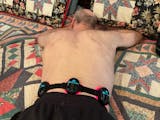Understanding the Efficacy of Low-Power Helium-Neon Laser Therapy for Chronic Pain Relief
Through a rigorously executed double-blind investigation, scientists delved into the possibilities of recurrent exposure to a low-power (1 mW) helium-neon laser as a means of easing chronic pain. The results of this examination unveiled the notable pain-relieving properties of this groundbreaking treatment, providing optimism for those suffering from ailments such as trigeminal neuralgia, post-herpetic neuralgia, sciatica, and osteoarthritis.
Study Design and Methodology
The research utilized stringent double-blind procedures in order to guarantee the dependability and accuracy of the findings. Participants were subjected to repeated exposure of the low-power helium-neon laser, with careful consideration given to precisely targeting specific regions of discomfort. It is worth mentioning that alleviation was observed following the irradiation of the skin above the radial, medial, and saphenous nerves, as well as in instances where the corresponding painful nerve was directly exposed to the laser.
Key Findings
The results of the study were striking:
- Significant Pain Relief: Nineteen out of the twenty-six subjects examined in the research study reported significant alleviation of pain, which is quite remarkable considering that no pharmaceutical medications were administered.
- Target-Specific Relief: Pain alleviation was specifically noted in regions supplied with nerves targeted for treatment. In contrast, application to skin areas lacking innervation by these nerves did not lead to pain relief, emphasizing the critical role of accuracy in targeting the affected regions.
- Biochemical Correlates: Subjects who were subjected to laser irradiation demonstrated a significant rise in the excretion of 5-hydroxyindoleacetic acid in their urine, which is a byproduct of serotonin degradation. This alteration in biochemical levels indicates a potential mechanism that may explain the analgesic effects of the therapy, potentially involving the modulation of serotonin pathways.
Implications and Future Directions
The management of chronic pain can be greatly influenced by the findings of this study. The use of low-power helium-neon laser therapy has shown promising analgesic effects, providing a potential alternative to conventional pharmacological treatments. This is especially beneficial for individuals who may have reservations or difficulties in tolerating pharmaceutical drugs.
Subsequent investigation is necessary to clarify the exact mechanisms that contribute to the pain-relieving properties of low-power laser therapy. Furthermore, extensive studies on a larger scale are required to authenticate these discoveries and investigate the sustained effectiveness and safety of this groundbreaking therapeutic method.
To summarize, the findings of this research highlight the capacity of low-power helium-neon laser therapy as a non-pharmacological approach to alleviate chronic pain. Through its ability to focus on particular pain sites and regulate biochemical processes, this treatment presents a hopeful opportunity to enhance the well-being of those enduring chronic pain ailments.
For more insights into innovative therapeutic approaches and the latest advancements in pain management, stay tuned to our blog. We delve into the science behind emerging treatments and provide updates on cutting-edge research, empowering individuals to make informed decisions about their health and well-being.
















Share:
Unlocking the Power of Low-Power Laser Therapy for Supraspinatus Tendinitis
Enhancing Oral Health During Head and Neck Cancer Treatment: The Role of Low-Level Laser Therapy (LLLT)